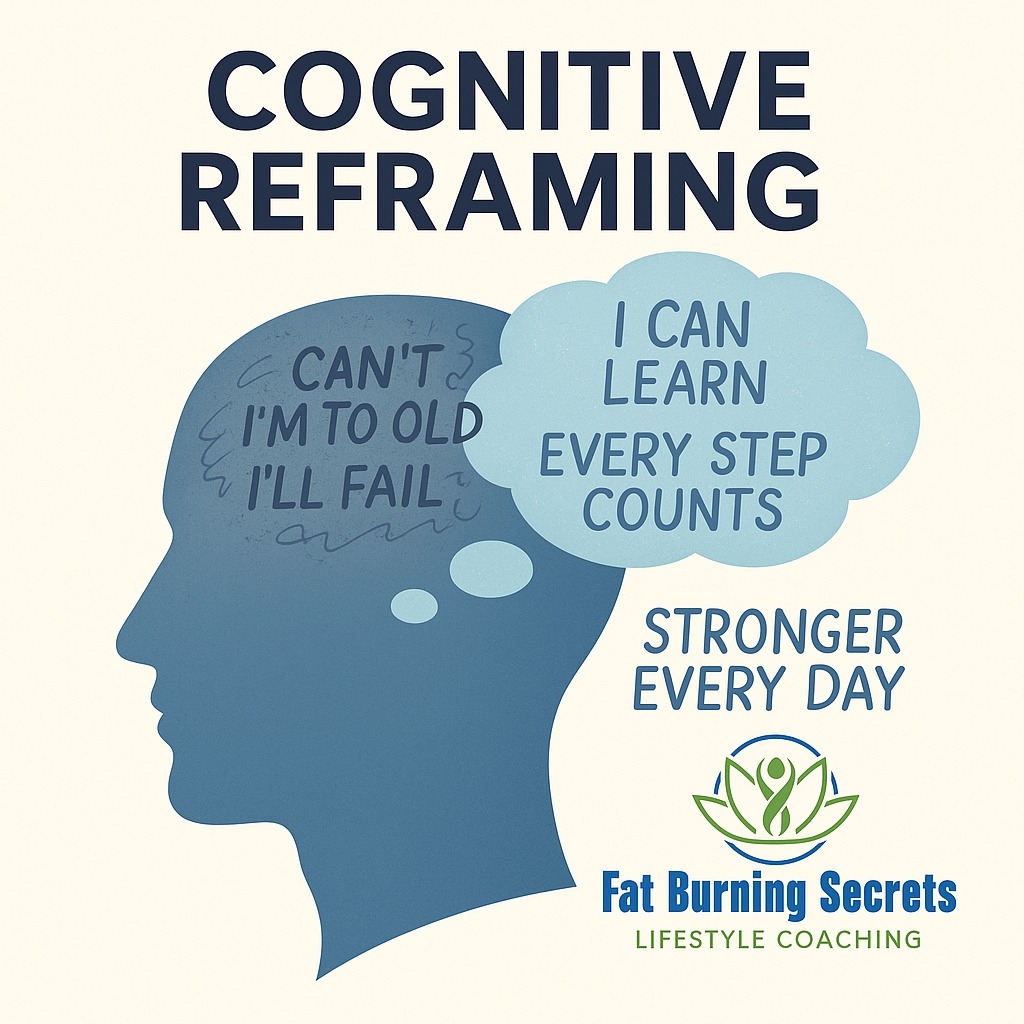In the world of personal change, it’s often our mindset—not our circumstances—that holds us back. If you’re struggling to stick to a healthy eating plan, maintain motivation in your workouts, or overcome negative self-talk, you need more than just willpower. You need a mental toolkit that lets you reframe unhelpful thoughts into empowering beliefs. That’s where cognitive reframing comes in. In this article, I define it and give a cognitive reframing example for clarity.

What Is Cognitive Reframing?
At its core, cognitive reframing definition is simple: it’s the process of identifying and shifting distorted or negative thought patterns into more balanced, constructive perspectives. Instead of viewing a setback as proof of failure, cognitive reframing teaches you to see it as data—information you can use to adjust your strategy.
Cognitive reframing definition: A mental technique in which you consciously change the way you interpret an event or belief in order to alter its emotional impact and drive positive action.
Why Cognitive Reframing Matters for Fat Loss and Fitness
Your brain is wired to protect you from harm—real or perceived. When you decide to change your eating habits after years of comfort foods, your mind sounds the alarm: “Danger! Deprivation ahead!” That instinct triggers stress hormones, cravings, and self-sabotage. By practicing cognitive reframing, you can:
- Reduce emotional eating: Turn “I’ll never stick to that diet” into “I’m learning which foods fuel my energy best.”
- Boost workout consistency: Swap “Ugh, another hard workout” for “Every session brings me closer to feeling strong.”
- Increase resilience: Transform “I messed up today” into “I have a plan to get right back on track tomorrow.”
A Simple Cognitive Reframing Example
To bring this technique to life, let’s look at a cognitive reframing example many of us face:
Situation: You skip your morning workout because you “didn’t have time.”
Automatic Thought: “I’m so lazy. I’ll never reach my goals.”
Emotion: Shame, discouragement.
Reframe: “Missing one workout doesn’t define me. I can move in the evening or plan a better schedule tomorrow.”
New Emotion: Relief, motivation.
By consciously choosing that healthier interpretation, you break the guilt-shame cycle and keep momentum toward your fitness goals.
Steps to Practice Cognitive Reframing
Here’s a quick, actionable process you can use anytime you notice unhelpful thinking:
- Notice the Thought. Become aware of negative or rigid self-talk (“I can’t,” “I always,” “I never”).
- Label the Distortion. Identify whether it’s all-or-nothing thinking, catastrophizing, or mind-reading.
- Gather Evidence. Ask yourself: “Is this thought 100% true? What facts support it? What facts contradict it?”
- Create a Balanced Alternative. Formulate a realistic reframe: “Instead of ‘I never have time,’ I can say, ‘I can find at least 10 minutes for movement each day.’”
- Notice the Shift. Pay attention to how the new thought changes your feeling and behavior.
Integrating NLP Techniques for Deeper Change
Neuro-Linguistic Programming (NLP) and cognitive reframing share the goal of shifting unhelpful thought patterns—and NLP offers specific tools to enhance your reframing practice:
- Reframing in NLP: NLP defines reframing as deliberately changing the meaning of an experience. If you think “I’m too old to build muscle,” NLP might ask, “What strength comes with age that can help you succeed?”
- Language Patterns & Submodalities: NLP shows that how you “see,” “hear,” and “feel” a thought impact its power. Changing a memory from vivid color to soft black-and-white can weaken negative emotions and strengthen positive ones.
- Anchoring Positive States: By pairing a physical trigger (like pressing fingertips) with a positive emotion, you can instantly access that empowering state when negative thoughts arise—making reframes stick faster.
- Meta Model Questions: Use precise questioning to challenge distorted beliefs: “Always? Who says? What’s another possibility?” This aligns with cognitive reframing’s step of gathering evidence and replacing distortions.
Combining NLP with cognitive reframing not only shifts your thinking but also embeds new, empowering beliefs more deeply—so they drive your fat loss and fitness habits automatically.
Real-Life Impact: A Client Story
One of my clients, Mark (age 58), came to us stuck in a cycle of “all-or-nothing” dieting. He’d start Monday strong and give up by Wednesday, telling himself “I blew it, might as well start fresh next week.” By learning cognitive reframing—and using NLP anchoring—Mark shifted to: “I can adjust my meals and still make today count.” Combined with a tailored meal plan and strength routine, he lost 15 lb of fat and gained lean muscle—without ever feeling deprived.
Bringing It All Together
Cognitive reframing is more than a buzzword; it’s a scientifically backed tool that rewires your brain’s automatic reactions, turning obstacles into opportunities. When paired with NLP techniques and personalized coaching, it becomes a catalyst for lasting change in how you eat, train, and live.
That’s what makes the Fat Burning Secrets Lifestyle Coaching Program different. I don’t just hand you a diet chart or a workout PDF. I coach you through mental hurdles, reprogram unhelpful beliefs, and give you a complete roadmap—backed by 100+ biomarkers—to optimize your body, mind, and results.
Ready to reframe your mind & reshape your body?
Discover how our program uses cognitive reframing and NLP as the foundation for your success:
👉 www.FatBurningSecrets.coach
Here’s to building stronger habits, a stronger mind, and a stronger you!



6 Responses
What a powerful and practical exploration of cognitive reframing—you break down the concept with such clarity, guiding readers through real-world examples that make the technique feel immediately doable and deeply impactful. I especially loved how you highlighted the importance of recognizing our mental “frames” and then actively shifting them—it’s one thing to understand reframing; it’s another to make it a habit.
Question for thought: How might someone integrate cognitive reframing into a daily routine—say, in the morning or before heading into a challenging meeting—to make it second nature rather than a reactive tool?
Great insight—thank you! I really like the idea of using intentional check-ins or journaling prompts as anchors for reframing. It makes sense that building awareness before we’re triggered can help shift our responses in the moment. I’m definitely going to try starting my day with a quick “What’s a new way I could look at ____?” question. Appreciate your perspective!
This really hit home for me. I’ve been working on shifting some negative thought patterns, and the way you explained cognitive reframing made it feel doable—not just another “think positive” cliché. The part about changing your internal questions was especially powerful. Great post, Richard. Thanks for making this practical and personal.
I’m so happy you found it useful, David. Thanks for the feedback.
Fantastic post, Richard! I appreciate how you clearly define cognitive reframing and walk readers through actionable examples—especially linking it to NLP for deeper mindset shifts. Your client story with Mark brings the concept to life in a relatable, inspiring way
Quick question: Have you experimented with integrating cognitive reframing into daily rituals—like morning journaling or pre-work visualization—to proactively build that mental resilience before challenges arise? Would love to hear how you help clients make reframing a consistent part of their day, not just a reactive tool.
Great question, Ryan—thank you!
Yes, absolutely. I’m really big on integrating routines like this into my coaching because I’ve found they’re not just effective—they’re what sets my coaching apart from a lot of the mindset work out there.
Cognitive reframing works best when it’s embedded into daily micro-practices, like:
Morning journaling: Clients write down one limiting belief and reframe it into an empowering thought to start the day with clarity.
Visualization rituals: Before stress points (meetings, workouts, etc.), we visualize success and pre-frame challenges—turning “what if I fail?” into “what can I learn either way?”
Evening reflection: A quick mental audit—“Where did I reframe successfully today?”—helps build self-trust and momentum.
Reframing isn’t a one-time mindset trick—it’s a daily habit that rewires your perspective and transforms your results.
Would love to hear how you or others in this thread build reframing into your routines!